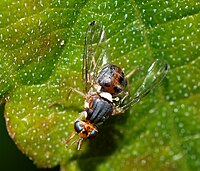
Photo from wikipedia
Olive fly ( Bactrocera oleae (Rossi, 1790) Gmelin) is one of the most important olive pests worldwide. Most plant protection measures are based on insecticides, especially organophosphates, pyrethroids, and recently… Click to show full abstract
Olive fly ( Bactrocera oleae (Rossi, 1790) Gmelin) is one of the most important olive pests worldwide. Most plant protection measures are based on insecticides, especially organophosphates, pyrethroids, and recently a spinosad. Insecticides are used as cover sprays or in more environmentally friendly methods in which insecticides are used in combination with attractants and pheromones as bait sprays or for mass trapping. However, due to negative impacts of insecticides to environment, new plant protection methods are constantly developing with the aim to lower the consumption of insecticides or even to eliminate them by biological control with entomopathogenic organisms, sterile insect technique (SIT), or transgenic method RIDL (release of insects carrying a dominant lethal). However, these methods need to be improved in order to guarantee adequate protection. Alternative methods than those traditionally used are required due to long term usage causing the development of resistance to the insecticides, ultimately lowering their effectiveness. Molecular methods for monitoring the frequencies of resistant alleles and the current status of resistance alleles in olive growing countries are reviewed here.
Journal Title: Acta Agriculturae Slovenica
Year Published: 2017
Link to full text (if available)
Share on Social Media: Sign Up to like & get
recommendations!